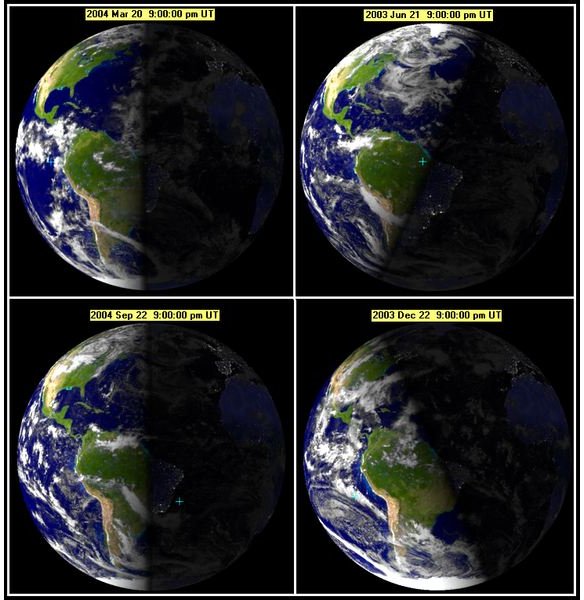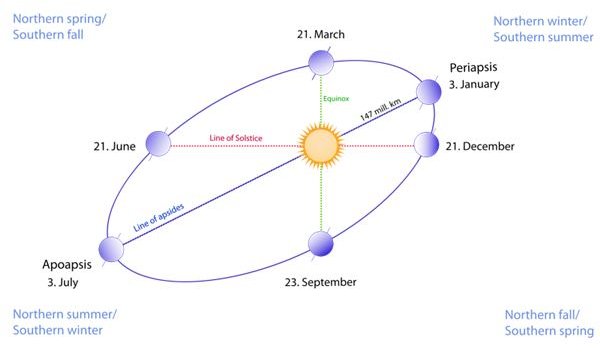Causes of Seasons: Axial Tilt and Sunlight Angle of Incidence Explained
What Are Seasons?
What are seasons? Winter, spring, summer, and fall, right? The answer may seem obvious at first glance, but let’s stop and think about it for a moment before we try to understand the main causes of seasons.
In the temperate middle latitudes on Earth, each year can be broken up into four parts based on temperature and amount of daylight. Winter is cold and dark. Summer is warm and bright. In between, the weather warms up with lengthening days (spring), or cools down with shortening days (fall).
Closer to the tropics, days and nights stay about the same length, and winters are relatively mild. Temperature-based seasons don’t really exist near the equator, though there are places with wet and dry seasons based on rainfall.
Meanwhile, at higher latitudes, the difference between winter and summer is much more extreme. Winters are very cold. Days become very short in the winter and very long in the summer. Near the poles, part of summer doesn’t have nights at all, and part of winter doesn’t have daylight.
So what causes the seasons to be as they are? Now let’s go out into space and see what the Earth is actually doing over the course of a year as it rotates and revolves around the Sun.
Sunlight Angle of Incidence
First, because the Earth is round, sunlight doesn’t fall on all parts of it equally. Places that face the Sun directly get sunlight from directly overhead, while places off to the side get sunlight at an angle. The higher the angle of incidence, the lower its density of rays per square meter, the more atmosphere it must pass through before it reaches Earth’s surface, and the less intense it is.
As the Earth rotates each day, and a given point moves from dawn to noon to dusk, the sunlight angle of incidence is high, then low, then high. As you move from pole to equator, the angle of incidence at noon moves toward zero - with the Sun straight overhead. Overall, the equator gets much more sunlight at higher intensity than the poles, which translates to more heat.
Axial Tilt

Second, the Earth’s axis of rotation isn’t perfectly vertical relative to its orbital path around the Sun, but is tilted at a 23.4o angle. As the Earth revolves around the Sun, sometimes the north pole points toward it, and other times it points away (and the south pole points toward the Sun). In between are parts where the axis is “sideways.” The exact astronomical moment when the Earth’s north pole points directly toward or away from the Sun is called a solstice, and the exact moment for perfect “sideways” is an equinox. The absolute direction that the axis points doesn’t change (relative to the Solar System during the course of a year), just the direction relative to the location of the Sun.
As the Earth rotates each day, the pole that is tilted toward the Sun always sees sunlight. Near the pole within the polar circle, the angle of incidence is still high, then low, then high - but the Sun never goes below the horizon.
As you move from polar circle to equator, the length of day shortens. Night appears outside the polar circle, then lengthens, until at the equator day and night are about the same.
Adding Revolution to the Rotation
The length of day also shortens as the Earth revolves away from a summer solstice toward a fall equinox, and the pole stops pointing toward the Sun. On the equinox, the length of time that the centerpoint of the Sun spends above and below the horizon is the same for the entire planet (but length of day is actually longer than night because the Sun is a disc, not a point; equal day and night is called <em>equilux</em>). After that, night continues to lengthen until the pole is always in darkness.
So, getting back to the causes of seasons: when a pole points toward the Sun, its hemisphere experiences summer, while the opposite hemisphere (with the pole in darkness) has winter. The day of solstice is either the longest or shortest day of the year for everywhere on the planet - but it’s much longer or shorter at higher latitudes than close to the equator.
What About Closeness to the Sun?
“Summer is when the Earth is close to the Sun, and winter is when the Earth is farther away.”
The above statement is false, and one of the most common misconceptions about the causes of the seasons. Where does it come from?

The orbital path of the Earth around the Sun is an ellipse, rather than a perfect circle. At some points along its path, the Earth is closer to the Sun, and at other points farther away - that part is true. But often, diagrams that illustrate the ellipse will exaggerate it to demonstrate their points, making it much more elongated than it actually is.
From there, it’s reasonable to assume that something close to a heat source will be warmer than something far from it, and since summer is warm and winter is cold, the seasons must be due to closeness to the Sun along the ellipse.
When we sit close to a heat source, we’re warmer than when we sit farther away. But stop and think about that for a moment too. Where are you warm? The parts that directly face the heat source? What about the parts off to the side? Or do you have to rotate back and forth a bit to warm up your sides and keep your front from getting too toasty? The same thing happens for the Earth, as measured by the Sun’s angle of incidence, which depends on the Earth’s axial tilt (see page 1).
Another common misconception is that the solstice points happen when the Earth is at its closest to the Sun (perihelion) and at its farthest from the Sun (aphelion). This is also false. The pattern of Earth’s axial tilt doesn’t match up quite so neatly with the orbital ellipse.
So What Does Closeness to the Sun Do?
While the closeness of the Earth to the Sun is not a major cause of the seasons, it does have some influence on the temperature ranges of whichever season is happening in each hemisphere. The Earth is closer when the southern hemisphere is having summer, and farther away when the southern hemisphere is having winter. Meanwhile, at the same time, the northern hemisphere has winter when the Earth is close, and summer when it’s far. As a result, on average the southern hemisphere has much warmer summers and much colder winters than the northern hemisphere.
Image Credits
Sunlight Angle of Incidence image by Rhcastilhos, public domain.
Axial Tilt image by Tom Ruen, public domain.
Ellipticial Orbit of the Earth image by Gothika, CC-A-SA 3.0 license.
